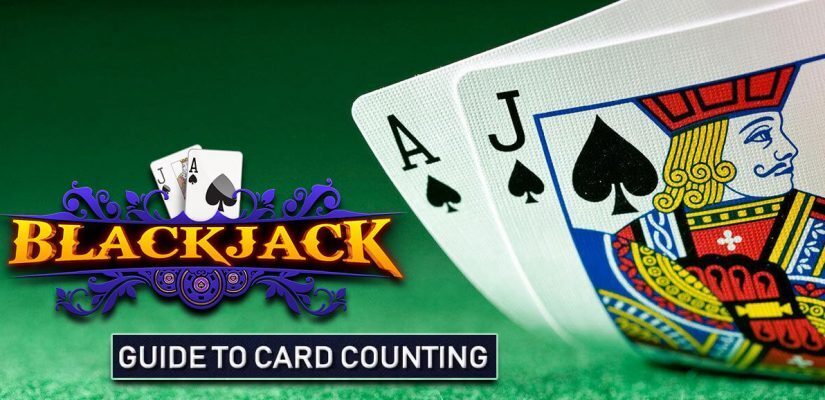
We have all seen the movies and TV shows where a savvy player takes the casino for millions of dollars by counting cards at blackjack. And while counting cards can be an effective way of tilting the odds in your favor, I will tell you right now that it is not nearly as glamorous as it may seem on the surface.
Not only do you need to have a huge bankroll to withstand the massive swings that are part of the game, but you also need to do a lot of homework, as counting cards is part art and part science. And even if you do all of those things right and manage to play perfect strategy and beat the house, you still have to find a way not to get caught and kicked out by casino security!
In this article, we are going to separate the facts from the myths and explain what card counting at blackjack is really about and give you TheSportsGeek’s top-5 tips for how to card count at blackjack. With that, let’s jump right into it by showing you the most popular ways to count cards at the blackjack table!
How To Count Cards In Blackjack
Do you want to know how to count cards in blackjack? Let’s take a look at the two most popular strategies to count cards, the high/low method and the ace/five method. And once you know how to count, we will then tell you how to use card counting in blackjack to win cold hard cash at the table!
High/Low Counting Method
The high/low method of card counting is the most simplistic and widely used way to count cards at blackjack. In a nutshell, you are going to assign a value to each card as it comes out of the deck based on its rank. Low cards count as +1, middle cards count as 0, and the big cards count as -1.
At the start of a new shoe, your count always starts at zero and will go up and down based on the cards that are dealt. If that sounds easy, it is because, in theory, it is. But keeping a running count of the deck is just a small part of counting cards at the blackjack table.
Once you get deep enough into the deck to start getting an accurate count (at least 1 full deck) you then divide your running total by the decks remaining to be dealt. This will give you what is known as the true count. Establishing a true count can be difficult at first, as you will need to get really good at eyeballing how many cards are left in the shoe, but once you get the hang of it, it will quickly become second nature.
The entire concept of card counting in blackjack is based on lots of high cards and aces being left in the deck being good for the players and lots of low cards left in the deck being good for the casino. That is because the more high cards that are left in the deck, the more often that the dealer will bust.
Anytime that your true count gets to a +4 or above, you should look for ways to increase your bets. If the count gets to -4 or lower, it would be a great time to sit out or move tables, as that count is going to cost you money. There are more detailed strategy guides out there on what to do in specific situations, but for the sake of this article, we are going to keep our tips high level, rather than getting lost in the details.
Ace/Five Counting Method
While the high/low method is very easy to learn and is widely used, it isn’t always the most accurate. The ace/five method of card counting is a new-age way to count cards that focuses on aces and fives and can get you a more accurate count to help guide you to better decisions.
Just like if you were using the high/low method, you start each new shoe with a count of zero. But, instead of having to count every card that is dealt, which can be a bit overwhelming at times, when you are counting using the ace/five method, all you are counting are the aces and fives, which is much easier to keep up with.
For every five that is dealt, you are going to add +1 to the count. For every ace dealt, you are going to subtract -1 from your running count. If the count gets to +2 or higher, you are going to want to double up your bets to take advantage of the deck that is in your favor. If your count gets to +10 or higher, you’ll want to press your bets to your max, as you stand to win a lot of money with a juicy shoe on tap.
Practice Counting At Home
I just threw a lot at you. And I promise you that counting cards, as easy as it may seem to just add or subtract based on the cards dealt, is hard to do, especially when you are trying it for the first time. The best way to get good at keeping a running count is to practice away from the table.
Having the wrong count calculated is much worse than not counting at all, as you are going to make meaningful decisions based on flawed data. Until keeping the count is as easy as breathing, you aren’t ready to try it at a casino. Luckily for you, cards are cards, and if all you do is deal to yourself at home and practice, you will start to get the hang of it in no time.
Pick The Right Game And Know The Rules
The movies might lead you to believe that counting cards is a foolproof way to get rich quickly. And while being an effective card counter will give you a big head start over a player that isn’t counting, there are some games, that no matter how well you count cards, you won’t be able to beat.
Most casual players don’t fully understand how small changes to the rule set can make a big difference in the casino’s edge. Rules like only being able to double on 10 or 11, only being able to split aces once, or losing the ability to surrender, are all rules that increase the house advantage for the casino.
If you are playing a typical low-limit game at your local casino, you are going to have a hard time finding optimal rule-set games. We could dive deep into all of these specific rules, but instead, I will list a couple of the more important ones that you should be looking for below.
Rules To Be On The Lookout For Before You Sit Down
- 4-8 decks
- Blackjack pays 3 to 2
- Dealer stands on soft 17
- Double after split allowed
- Late surrender allowed
- Re-splitting aces allowed
Don’t Get Caught!
Now that you have an idea of what card counting at blackjack actually is and what it isn’t, the last piece of the puzzle is getting out the front door with the money! If you do all of the above things perfectly and use your card counting skills to beat the casino and make money, you still have to make sure that you don’t get caught.
Card counting isn’t technically illegal, but it is heavily frowned upon, and if a casino even suspects that you are counting cards, they are going to refuse your action and kick you out. You could go the movie route and focus your efforts on distracting the pit bosses or wearing elaborate disguises to keep the casino off of your scent, but that is mostly unnecessary.
The best way to keep the casino from catching on to your card counting strategy is to make sure that you aren’t getting greedy.
If every time that the count gets good for you, you bet 10x your normal wager, it is a red flag for casino security. I hate to break it to you, but the casino knows how to count cards too, and you have to make sure that you stay under the radar, even if that means occasionally giving up expected value (EV) to stay incognito.
There is no value to counting cards if you aren’t adjusting your strategy to correspond with the count, but you must make sure that you are very careful when you do it, so you don’t end up in the black book and get banned. Every great card counter that has been caught over the years has one thing in common, and that is that they got too greedy and pushed harder than they should have.
Conclusion
Are you ready to go full Rain Man and start counting cards? Make sure that you do your homework before you ever step foot inside of a casino. Know which method you want to use, ensure that the rules of the table you are at are optimal, or as close to it as possible, and most importantly, don’t get caught!
Online, you will have far fewer distractions, which should help you focus on improving your counting ability. And with lower limits online than at brick-and-mortar casinos, you will be able to hone your skills without going broke.
Don’t have a favorite online casino yet? Make sure that you swing by TheSportsGeek’s blackjack sites page, where we bring our readers exclusive offers at all of the top online casinos. Thanks for reading and good luck on your card counting journey, and who knows, maybe one day you will be the star of the next Hollywood movie as a player that beat Vegas by counting cards at blackjack!




You must be logged in to comment. Don't have an account? Sign up today.